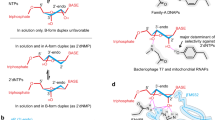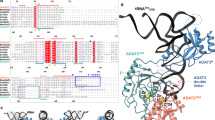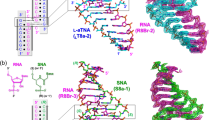Abstract
THE functional analysis of determinants on RNA has been largely limited to molecules that contain naturally occurring ribonucleotides, so little is known about the role of 2′-hydroxyl groups in protein–RNA recognition. A single base pair (G3·U70) in the acceptor stem of tRNAAla is the principal element for specific recognition by Escherichia coli alanine-tRNA synthetase1,2. This tRNA synthetase aminoacylates small RNA helices that contain the G3·U70 base pair. Furthermore, removal of the G3 exocyclic 2-amino group that projects into the minor groove eliminates aminoacylation3. This 2-amino group is flanked on either side by ribose 2′-hydroxyl groups that line the minor groove. Here we use chemical synthesis to construct 32 helices that make deoxy and O-methyl substitutions of individual and multiple 2′-hydroxyl groups near and beyond the G3·U70 base pair and find that functional 2′-hydroxyl contacts are clustered within a few angstroms of the critical 2-amino group. These contacts are highly specific and make a thermodynamically significant contribution to RNA recognition.
This is a preview of subscription content, access via your institution
Access options
Subscribe to this journal
Receive 51 print issues and online access
$199.00 per year
only $3.90 per issue
Buy this article
- Purchase on Springer Link
- Instant access to full article PDF
Prices may be subject to local taxes which are calculated during checkout
Similar content being viewed by others
References
Hou, Y.-M. & Schimmel, P. Nature 333, 140–145 (1988).
McClain, W. H. & Foss, K. Science 240, 793–796 (1988).
Musier-Forsyth, K. et al. Science 253, 784–786 (1991).
Francklyn, C., Shi, J.-P. & Schimmel, P. Science 255, 1121–1125 (1992).
Musier-Forsyth, K., Scaringe, S., Usman, N. & Schimmel, P. Proc. natn. Acad. Sci. U.S.A. 88, 209–213 (1991).
Wang, A. H.-J. et al. Nature 299, 601–604 (1982).
Dock-Bregeon, A. C. et al. Nature 335, 375–378 (1988).
Hall, K. B. & McLaughlin, L. W. Biochemistry 30, 10606–10613 (1991).
Bevilacqua, P. C. & Turner, D. H. Biochemistry 30, 10632–10640 (1991).
Chowrira, B. M. & Burke, J. M. Biochemistry 30, 8518–8522 (1991).
Perreault, J.-P., Labuda, D., Usman, N., Yang, J.-H. & Cedergren, R. Biochemistry 30, 4020–4025 (1991).
Pyle, A. M. & Cech, T. R. Nature 350, 628–631 (1991).
Scaringe, S. A., Francklyn, C. & Usman, N. Nucleic Acids Res. 18, 5433–5441 (1990).
Schreier, A. A. & Schimmel, P. Biochemistry 11, 1582–1589 (1972).
Jasin, M., Regan, L. & Schimmel, P. J. biol. Chem. 260, 2226–2230 (1985).
Author information
Authors and Affiliations
Rights and permissions
About this article
Cite this article
Musier-Forsyth, K., Schimmel, P. Functional contacts of a transfer RNA synthetase with 2′-hydroxyl groups in the RNA minor groove. Nature 357, 513–515 (1992). https://doi.org/10.1038/357513a0
Received:
Accepted:
Issue Date:
DOI: https://doi.org/10.1038/357513a0
This article is cited by
-
Wobble puts RNA on target
Nature (2014)
-
The selective tRNA aminoacylation mechanism based on a single G•U pair
Nature (2014)
-
'Distorted' RNA helix recognition
Nature (1996)
-
Protein-RNA molecular recognition
Nature (1996)
-
Enzymatic RNA synthesis and RNase P
Molecular Biology Reports (1996)
Comments
By submitting a comment you agree to abide by our Terms and Community Guidelines. If you find something abusive or that does not comply with our terms or guidelines please flag it as inappropriate.



